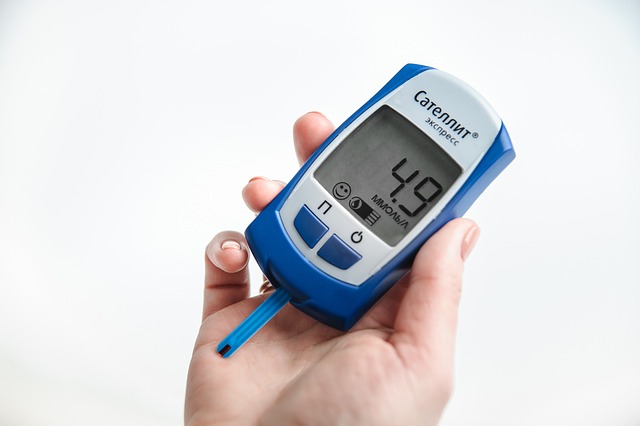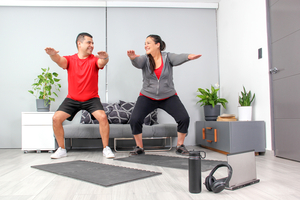Back pain is no stranger to many of us. In fact, experts estimate that 80% of people in the U.S. will have back pain at some point in their lives.[1]
One of the major factors that contributes to back pain is carrying extra pounds. If you are overweight, have low back pain, and want to prevent future health complications like prediabetes down the line, then taking action now is key.
If you start taking steps to relieve your pain now, you'll be able to increase your activity levels and regain your health before more serious problems arise.
Being overweight increases your chances of having back pain
There are many things that can cause back pain like injuries, arthritis, and degenerative conditions.[2] But it isn't always an injury or a health condition that causes back pain.
One important factor to consider is obesity. Being overweight or obese is associated with high levels of low back pain. If you are overweight or obese, your odds of having low back pain are 15% higher than someone who is of normal weight.[3,4] The results from one study in over 9,000 women suggested that for each additional 11 pounds of weight, there is a 5% increased risk of back pain.[5]
There are several theories to explain why obesity is associated with high levels of back pain. Some relate to the way body mechanics shift when you have excess weight, which may put strain on your back in a way that isn't intended. Others relate to how obesity can lead to changes within the body that increase inflammation, which can also add to back pain.[6]
No matter the exact mechanism, the research clearly shows that obesity and back pain are tightly linked.
Links between back pain, lack of physical activity, and prediabetes
As if the pain itself weren't enough to deal with, the detrimental effects of back pain are much more widespread than that. Having low back pain can also put you at risk for a variety of other health conditions like prediabetes.
A major reason for this is that back pain may stop you from moving your body and can contribute to a sedentary lifestyle.
When you are dealing with back pain, it can become very difficult to keep up with normal day-to-day activities. In fact, low back pain is the most common cause of disability in people under 45 years of age.[1]
It is not surprising that many people with this condition – especially when they have pain that has become disabling – aren't as active as people who are pain free.[7] People with low back pain often report that they aren't able to be as active due to barriers like being in pain, being tired, and being stressed.[8] Many people with back pain also live in fear of injuring themselves further, which can lead to anxiety and avoidance of physical activity.[9]
One problem with this is that lack of physical activity is also a known risk factor for low back pain.[10] This creates a vicious cycle. Your pain stops you from being active, and your lack of activity in turn makes your pain even worse.
Another major problem with the inactivity caused by low back pain is that low levels of physical activity are correlated with abnormal blood sugars and an increased risk of prediabetes.[11-13]
This means that the less you move your body, the more likely you are to get high blood sugar and prediabetes, which can lead to type 2 diabetes down the road if left unchecked. In fact, studies have shown that having low back pain can increase your risk for getting diabetes.[14]
So if you are overweight, have low back pain, and have trouble staying active, what can you do to keep yourself safe and prevent problems like prediabetes?
You can work on strengthening your body to relieve your pain and get back to better health.
Tips for relieving back pain and regaining your health
Obesity, low back pain, and lack of physical activity are all related. And each of them is a risk factor for prediabetes.[11-14]
You don't deserve to live in constant pain that affects your ability to function in daily life. And you probably don't want that pain to cause long-term health issues like prediabetes or diabetes in the future.
Here's what you can do to relieve back pain, lose some weight, and get yourself back in better health:
1. Move your body regularly
If you have low back pain, you may avoid moving your body as much as possible. After all, you are in pain and may fear that any extra activity will just make things worse.
But the truth is, staying physically active is one of the best ways to combat back pain.[9] Experts believe that moving your body and getting exercise are integral parts of managing and rehabilitating low back pain.[8]
Moving your body can be as simple as taking periodic breaks during your workday to walk around the office or do a few stretches. It can look like switching the position you are sitting in regularly or using a standing desk. It doesn't matter if you walk or dance; the goal is to sit less and move more.[1,2]
2. Focus on strength and flexibility
While anything you can do to sit less and move more is helpful, some types of exercise are particularly beneficial. Exercises that combine strength and flexibility are the best options for back pain.[9] Consider low-impact options like stretching, walking, yoga, gentle strength-training, and Pilates that keep your muscles strong and flexible.[2,15,16]
Start small and slow, and don't push it. Short walks or gentle stretching sessions using poses like Cat Cow might be a great way to start. You can gradually work up to more and more activity each day. Be sure to work with a doctor or physical therapist to determine a safe, appropriate exercise routine that is right for you.
3. Support your back in daily activities
Give your back the support it needs by using furniture and equipment with proper ergonomics both at home and at work. If you don't have the right tools, try using a rolled-up towel placed in the hollow of your back when you are sitting in a chair or in the car, for example. And be sure to wear comfortable, supportive shoes.[1,2]
4. Eat well
Anything you can do to maintain a healthy weight will help you to relieve your back pain and get back on track. Following a healthy diet will support your body overall, and it can help you to lose some extra pounds as well.[2]
Key takeaways
Being overweight or obese can be very harmful to the body in a myriad of ways. It's important to know that if you are obese, you may be at higher risk for conditions like low back pain and prediabetes.
If you are overweight, have back pain, and have trouble staying active, you may be at particularly high risk for getting prediabetes.
The #1 thing you can do to relieve your pain and limit your risk is to start moving your body more. Getting physically active in a way that is safe for your body will help you to relieve your back pain, get your blood sugars back in control, and restore your overall health. Using proper back support and eating a healthy diet are also key.
Want more guidance on your journey towards better health? Lark is here for you. Consider trying our Diabetes Prevention Program, which helps you every step of the way when it comes to changing your diet and lifestyle to take care of your body and reduce your prediabetes risk.
References
- Chronic Back Pain. Cleveland Clinic. https://health.clevelandclinic.org/lifestyle-changes-to-ease-back-pain.
- Low Back Pain Fact Sheet. National Institutes of Health. Updated April 27 2020. https://www.ninds.nih.gov/disorders/patient-caregiver-education/fact-sheets/low-back-pain-fact-sheet.
- Chou L, Brady SR, Urquhart DM, et al. The Association Between Obesity and Low Back Pain and Disability Is Affected by Mood Disorders: A Population-Based, Cross-Sectional Study of Men. Medicine (Baltimore). 2016;95(15):e3367.
- Zhang TT, Liu Z, Liu YL, et al. Obesity as a Risk Factor for Low Back Pain: A Meta-Analysis. Clin Spine Surg. 2018;31(1):22-27.
- Brady SR, Hussain SM, Brown WJ, et al. Relationships Between Weight, Physical Activity, and Back Pain in Young Adult Women. Medicine (Baltimore). 2016;95(19):e3368.
- Hussain SM, Urquhart DM, Wang Y, et al. Fat mass and fat distribution are associated with low back pain intensity and disability: results from a cohort study. Arthritis Res Ther. 2017;19(1):26.
- Lin CW, McAuley JH, Macedo L, Barnett DC, Smeets RJ, Verbunt JA. Relationship between physical activity and disability in low back pain: a systematic review and meta-analysis. Pain. 2011;152(3):607-13.
- Schaller A, Exner AK, Schroeer S, Kleineke V, Sauzet O. Barriers to Physical Activity in Low Back Pain Patients following Rehabilitation: A Secondary Analysis of a Randomized Controlled Trial. Biomed Res Int. 2017;2017:6925079.
- Grabovac I, Dorner TE. Association between low back pain and various everyday performances: Activities of daily living, ability to work and sexual function. Wien Klin Wochenschr. 2019;131(21-22):541-549.
- Citko A, Górski S, Marcinowicz L, Górska A. Sedentary Lifestyle and Nonspecific Low Back Pain in Medical Personnel in North-East Poland. Biomed Res Int. 2018;2018:1965807.
- Prediabetes Modifiable Risk Factors. American Heart Association. Reviewed August 30 2015. https://www.heart.org/en/health-topics/diabetes/understand-your-risk-for-diabetes
- Diabetes Risk Factors. Centers for Disease Control and Prevention. Reviewed March 24 2020. https://www.cdc.gov/diabetes/basics/risk-factors.html
- Mainous AG 3rd, Tanner RJ, Anton SD, Jo A, Luetke MC. Physical Activity and Abnormal Blood Glucose Among Healthy Weight Adults. Am J Prev Med. 2017;53(1):42-47.
- Heuch I, Heuch I, Hagen K, et al. Is chronic low back pain a risk factor for diabetes? The Nord-Tr√∏ndelag Health Study. BMJ Open Diabetes Res Care. 2018;6(1):e000569.
- Lin HT, Hung WC, Hung JL, et al. Effects of pilates on patients with chronic non-specific low back pain: a systematic review. J Phys Ther Sci. 2016;28(10):2961-2969.
- Hicklin, T. Yoga eases moderate to severe low back pain. National Institutes of Health. June 27 2017. https://www.nih.gov/news-events/nih-research-matters/yoga-eases-moderate-severe-chronic-low-back-pain.











.webp)






